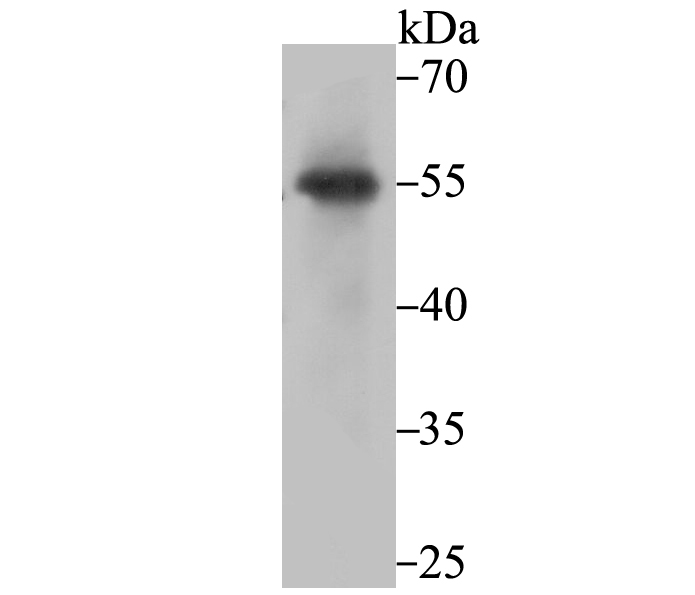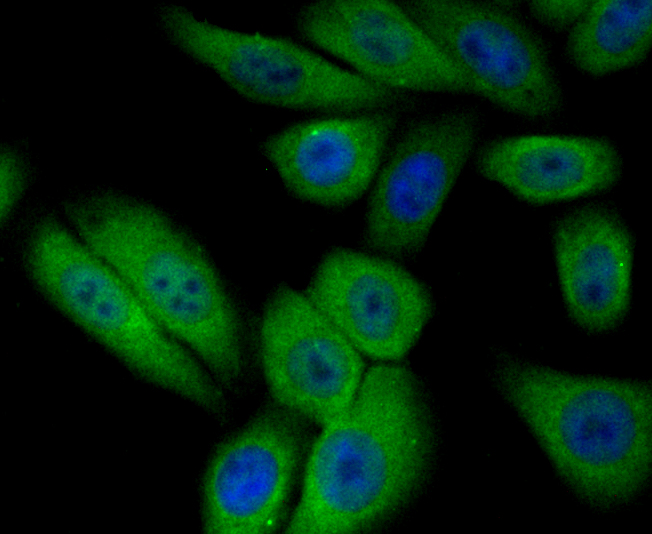Product Name :
PIST polyclonal antibody Background :
PIST (PDZ protein interacting specifically with TC10), also known as GOPC (golgi associated PDZ and coiled-coil motif containing), CAL or FIG, is a 462 amino acid protein that localizes to the cytoplasm, as well as to the membrane of the golgi apparatus and to the cell junction. Expressed ubiquitously and containing one PDZ (DHR) domain, PIST functions as a homooligomer that interacts with a variety of proteins and plays a role in intracellular protein trafficking and degradation. Additionally, PIST is thought to regulate ionic currents via membrane channel modification and may also play a role in autophagy. Chromosomal aberrations in the gene encoding PIST are found in glioblastoma multiform (GBM), a common and aggressive form of brain tumor, suggesting a role for mutated PIST in carcinogenesis. Three isoforms of PIST exist due to alternative splicing events. Product :
Rabbit IgG, 1mg/ml in PBS with 0.02% sodium azide, 50% glycerol, pH7.2 Storage&Stability :
Store at +4°C after thawing. Aliquot store at -20°C. Avoid repeated freeze / thaw cycles. Specificity :
PIST polyclonal antibody detects endogenous levels of PIST protein. Immunogen :
Recombinant protein within human PIST aa 1-100. Conjugate :
Unconjugated Modification :
Unmodification
PIST polyclonal antibody Background :
PIST (PDZ protein interacting specifically with TC10), also known as GOPC (golgi associated PDZ and coiled-coil motif containing), CAL or FIG, is a 462 amino acid protein that localizes to the cytoplasm, as well as to the membrane of the golgi apparatus and to the cell junction. Expressed ubiquitously and containing one PDZ (DHR) domain, PIST functions as a homooligomer that interacts with a variety of proteins and plays a role in intracellular protein trafficking and degradation. Additionally, PIST is thought to regulate ionic currents via membrane channel modification and may also play a role in autophagy. Chromosomal aberrations in the gene encoding PIST are found in glioblastoma multiform (GBM), a common and aggressive form of brain tumor, suggesting a role for mutated PIST in carcinogenesis. Three isoforms of PIST exist due to alternative splicing events. Product :
Rabbit IgG, 1mg/ml in PBS with 0.02% sodium azide, 50% glycerol, pH7.2 Storage&Stability :
Store at +4°C after thawing. Aliquot store at -20°C. Avoid repeated freeze / thaw cycles. Specificity :
PIST polyclonal antibody detects endogenous levels of PIST protein. Immunogen :
Recombinant protein within human PIST aa 1-100. Conjugate :
Unconjugated Modification :
Unmodification
-
 Western blot analysis of PIST on SiHa cell using anti-PIST antibody at 1/1,000 dilution.
Western blot analysis of PIST on SiHa cell using anti-PIST antibody at 1/1,000 dilution. -
 ICC staining PIST in HepG2 cells (green). The nuclear counter stain is DAPI (blue). Cells were fixed in paraformaldehyde, permeabilised with 0.25% Triton X100/PBS.
ICC staining PIST in HepG2 cells (green). The nuclear counter stain is DAPI (blue). Cells were fixed in paraformaldehyde, permeabilised with 0.25% Triton X100/PBS.
Bioworld Biotech only provide peptides for our antibodies and do not provide additional peptide customization services.
Price/Size :
USD 368/1mg/vial
Tips:
For phospho antibody, we provide phospho peptide(0.5mg) and non-phospho peptide(0.5mg).Describe :
Blocking peptides are peptides that bind specifically to the target antibody and block antibody binding. These peptide usually contains the epitope recognized by the antibody. Antibodies bound to the blocking peptide no longer bind to the epitope on the target protein. This mechanism is useful when non-specific binding is an issue, for example, in Western blotting (WB) and Immunohistochemistry (IHC). By comparing the staining from the blocked antibody versus the antibody alone, one can see which staining is specific; Specific binding will be absent from the western blot or IHC performed with the neutralized antibody.Formula:
Synthetic peptide was lyophilized with 100% acetonitrile and is supplied as a powder. Reconstitute with 0.1 ml DI water for a final concentration of 10 mg/ml.The purity is >90%,tested by HPLC and MS.
Storage:
The freeze-dried powder is more stable. For short time at 2-8°C. For long term storage store at -20°C.
Note :
This product is for research use only (RUO only). Not for use in diagnostic or therapeutic procedures.
 PIST polyclonal antibody
PIST polyclonal antibody  Datasheet
Datasheet COA
COA MSDS
MSDS SHIP
SHIP